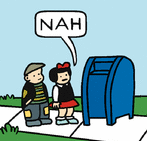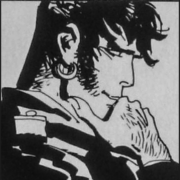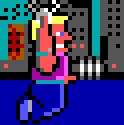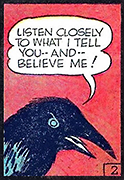|
Edgar Allen Ho posted:Good thing she went down at night or who knows what might have happened to the people on board The Carpathia was only about 60 miles away. The Mount Temple was even closer but was much slower and was approaching from the other side of the icefield, so never actually reached the site of the sinking. So the range of the wireless wasn't a factor - the Titanic was able to raise her sistership, the Olympic which was 500 miles away during the disaster. The really horrible thing to think about is that the wireless set on Titanic actually failed on the evening of April 13, having previously broken down shortly after the ship left Belfast - the transmitting power of the set and the non-stop use it was getting was burning out the transformer winding insulation. The Marconi Company rules were very clear that radio operators were not to make running repairs to the set - they were operators, not technicians. If the set broke then it would be out of action until the ship reached port. But on the Titanic operators Jack Phillips and Harold Bride broke the rules and patched up the set themselves using parts from the back-up transmitter on board. After seven hours of work the wireless was back in operation in the afternoon of April 14th, just hours before the ship struck the iceberg. If Harold and Bride hadn't bent the rules, or if they hadn't had the technical knowledge of how to repair the set, or if they hadn't been the 1912 equivalent of computer geeks who were happy to go above and beyond, go without sleep and pull the set apart because they were two 20-somethings who had the jobs they did mostly because they loved working with this new and exciting technology, then the Titanic would have gone down without anyone knowing where or when, leaving 700 people bobbing around the North Atlantic in open boats with a gale arriving the next day. You could have been looking at the Titanic as not one of the most tragic and well-studied disasters of history, but as the most compelling nautical mysteries of how a 50,000-ton brand new steamship with 2200 people onboard disappeared without trace on its maiden voyage.
|
|
|
|

|
| # ? May 28, 2024 11:38 |
|
Loxbourne posted:And then the Titanic's radio operator is ordered to clear a backlog of messages from first class passengers, most notably a stack of bets and live horse-race commentary. This means when a neighbouring ship, the SS Californian, sends an alert that the Titanic is in the middle of an ice field and they are stopping all engines for the night for safety, he responds (with his big shiny transmitter) with "SHUT UP SHUT UP I AM WORKING CAPE RACE." I'd say thats still pretty debatable. The cold water mirage theory that started within the last like 8 years seems to do a good job of explaining some of the mysteries of the night. Besides it was only about a hour or so between the moment where the Titanic fired its first rockets and when it sank. The Californian had stopped for the night due to ice fields. It would have taken time to get the engines back up and to navigate through the ice to reach the position of the Titanic. Not to mention the fact the location of the wreck and the location the Titanic gave out that night were some 13 miles away. DurosKlav has a new favorite as of 15:06 on Nov 18, 2019 |
|
|
|
Funny thing is that until they did deep-sea expeditions to find the wreck, it was believed the Titanic sank in one piece rather than two. (hence Raise the Titanic being remotely plausible) Which was pretty recent I think, iirc Ghostbusters 1 or 2 has the gag with the Titanic pulling into port.
|
|
|
|
Ghost Leviathan posted:Funny thing is that until they did deep-sea expeditions to find the wreck, it was believed the Titanic sank in one piece rather than two. (hence Raise the Titanic being remotely plausible) Which was pretty recent I think, iirc Ghostbusters 1 or 2 has the gag with the Titanic pulling into port. It was 2, which actually came out after the discovery of the wreck. So it was just the ghost of the ship I guess. Also Cheech Marin is one of the dockworkers in that scene. DurosKlav has a new favorite as of 15:39 on Nov 18, 2019 |
|
|
|
DurosKlav posted:I'd say thats still pretty debatable. The cold water mirage theory that started within the last like 8 years seems to do a good job of explaining some of the mysteries of the night. Besides it was only about a hour or so between the moment where the Titanic fired its first rockets and when it sank. The Californian had stopped for the night due to ice fields. It would have taken time to get the engines back up and to navigate through the ice to reach the position of the Titanic. Not to mention the fact the location of the wreck and the location the Titanic gave out that night were some 13 miles away. Very debatable, to say the least. While I don't think there's really any doubt that the Californian was looking at the Titanic (they saw a large ship come up from the east, stop at 11:40pm, fire off rockets between 12:15am and 1:50am and disappear at 2:20am...), I do believe that the exceptionally calm, clear and cold weather conditions that night caused all sorts of problems for the crew of both ships in sighting and messaging each other. Both Titanic and Californian flashed Morse lamp messages at each other without seeing any response. The Californian saw rockets, but the officer of the watch maintained that they burst below the 'mystery ship's' masthead light, when the Titanic's rockets would have burst at around three times the height of the masthead. No one on the Californian heard the loud explosive reports the rockets made when they burst or the equally deafening (and much longer) noise of the Titanic's safety valves lifting. I think the Californian was looking at a mirage of the Titanic that was much further away than it appeared to be, with the rockets bursting through an inversion layer above the ship and intermingling with the looming mirage. There was also the matter of the timing of the rockets being fired from the Titanic - irregularly at an average of one every eight minutes or so, but with some being a couple of minutes apart. That was not in keeping with the regulations on distress signals and that, coupled with the distortion effects of the mirage, was enough to prevent the officer on the Californian from realising what he was seeing and taking action. It's all rather moot, as you say, because even if the Californian had got underway as soon as they saw the first couple of rockets they would, at the very best, arrive just as the Titanic slipped under and they lacked the boats or the crew to mount an effective rescue. As for Phillips telling Evans on the Californian to 'shut up', this wasn't seen as an insult or angry put-down. It was entirely normal slang used between operators. Phillips was trying to work the distant station at Cape Race and hear its faint returning signal, which the Californian, only 20-30 miles away, was loudly 'overspeaking'. For his part, Evans didn't sign off and go to bed in a huff. But as a single operator he couldn't work all night, it was 11.30pm and if the Titanic was going to block the airwaves with its much more powerful transmitter sending out personal messages of no relevance then he might as well shut down the set. The other tantalising thing is that the Third Officer of the Californian, Charles Groves, was interested in wireless telegraphy and held a Board of Trade signals certificate - he could read Morse by lamp and pass messages by flag and semaphore, but was teaching himself to hear and send Morse in the much more rapid-fire, slang-laden way used by the wireless operators. The Californian had only been fitted with wireless earlier in 1912 and Groves was making a habit of dropping into the radio cabin to try and get an ear for the transmissions. On April 14th his watch ended at midnight and shortly afterwards he went to the wireless cabin. Evans was already asleep but, just about the moment Titanic was sending it's first distress signals, he put the earphones on and closed the switch to put power to the set. Unfortunately Evans hadn't wound the mechanism of the detector which converted the wireless signal to an electric pulse, so Groves heard nothing. He switched off the set and went to bed.
|
|
|
|
C.M. Kruger posted:First a brief explanation of the behavior of radio waves, essentially the way things work is the lower the frequency the more distance you can get out of your signal. AM/Medium Wave and Shortwave signals can easily travel around the world, while VHF signals (TV and FM radio, ham radio walky talkies) are more local but still "bouncy" enough to get over the horizon, and UHF/microwave+ signals (TV, wifi, commercial FRS/GMRS walky talkies, LTE phones, microwave backbones for telcos, etc) are basically line-of-sight only but do have better performance inside buildings or in forests. Reminds me of a plot point in Never Cry Wolf, where the guy that got dumped into the arctic wilderness uses his radio to contact someone in Peru, who eventually manages to get his request for help back to the people who can actually do something about it.
|
|
|
|
Loxbourne posted:And then the Titanic's radio operator is ordered to clear a backlog of messages from first class passengers, most notably a stack of bets and live horse-race commentary. This means when a neighbouring ship, the SS Californian, sends an alert that the Titanic is in the middle of an ice field and they are stopping all engines for the night for safety, he responds (with his big shiny transmitter) with "SHUT UP SHUT UP I AM WORKING CAPE RACE." Linking this again. https://m.youtube.com/watch?v=FxRN2nP_9dA
|
|
|
|
Heres a good post about the Mirage theory. I do not know if its the actual guy who wrote the book about it or someone pretending to be him but it does a good job of explaining it. And heres the show they made about it on the National Geographic channel https://www.youtube.com/watch?v=UxQvij8Ttug I do agree that Stanley Lord and the Californian were negligent in their duty. They probably should have woken Evans up and got the radio going. But as I said before I dont believe the ship was really in any position to render any useful aid to the Titanic itself. DurosKlav has a new favorite as of 02:13 on Nov 19, 2019 |
|
|
|
BalloonFish posted:The Carpathia was only about 60 miles away. The Mount Temple was even closer but was much slower and was approaching from the other side of the icefield, so never actually reached the site of the sinking. So the range of the wireless wasn't a factor - the Titanic was able to raise her sistership, the Olympic which was 500 miles away during the disaster. Now this is why I click the thread
|
|
|
|
BalloonFish posted:As for Phillips telling Evans on the Californian to 'shut up', this wasn't seen as an insult or angry put-down. It was entirely normal slang used between operators. Phillips was trying to work the distant station at Cape Race and hear its faint returning signal, which the Californian, only 20-30 miles away, was loudly 'overspeaking'. For his part, Evans didn't sign off and go to bed in a huff. But as a single operator he couldn't work all night, it was 11.30pm and if the Titanic was going to block the airwaves with its much more powerful transmitter sending out personal messages of no relevance then he might as well shut down the set. To elaborate on this a bit, spark gap transmitters are effectively the radio version of starting a irresponsibly large bonfire to make smoke signals. The signals were wide bandwidth, dirty and blotted out large sections of the bands available with what limited tuning was available with the pre-vacuum tube radios, and relied on dumping as much power as possible into the air to overcome the technical limitations they were operating under, so nearby stations would stomp on each other's signals or make it impossible for the other station to receive things while they were transmitting. By comparison Morse code sent in CW with a vacuum tube or transistor/solid state radio is going to be a 400hz wide laser beam. A single-sideband ham or military voice transmission will be around 2400hz, AM broadcast transmission is going to be like a 9000hz signal and FM broadcast is like 16,000hz, and all of these will be able to be tuned to different frequencies. https://www.youtube.com/watch?v=s8EgTyzG1gI Even ham radio operators had stopped using them shortly after tubes were invented, and by the late 1920s they had been banned entirely by the various regulatory agencies. And it did result in one of the first "hacks" in history when a magician who'd been hired to spy on Marconi by the wired telcos played a prank on him: https://www.newscientist.com/article/mg21228440-700-dot-dash-diss-the-gentleman-hackers-1903-lulz/ quote:Marconi claimed that his wireless messages could be sent privately over great distances. “I can tune my instruments so that no other instrument that is not similarly tuned can tap my messages,” Marconi boasted to London’s St James Gazette in February 1903.
|
|
|
|
C.M. Kruger posted:
Milo and POTUS posted:Now this is why I click the thread
|
|
|
|
C.M. Kruger posted:Maskelyne came from an inventive family – his father came up with the coin-activated “spend-a-penny” locks in pay toilets.
|
|
|
|
C.M. Kruger posted:To elaborate on this a bit, spark gap transmitters are effectively the radio version of starting a irresponsibly large bonfire to make smoke signals. The signals were wide bandwidth, dirty and blotted out large sections of the bands available with what limited tuning was available with the pre-vacuum tube radios, and relied on dumping as much power as possible into the air to overcome the technical limitations they were operating under, so nearby stations would stomp on each other's signals or make it impossible for the other station to receive things while they were transmitting. By comparison Morse code sent in CW with a vacuum tube or transistor/solid state radio is going to be a 400hz wide laser beam. A single-sideband ham or military voice transmission will be around 2400hz, AM broadcast transmission is going to be like a 9000hz signal and FM broadcast is like 16,000hz, and all of these will be able to be tuned to different frequencies. Is that the same Maskelyne as the guy who made Alexandria Harbour vanish, or is this just a family of insanely precocious magicians?
|
|
|
|
Werong Bustope posted:Is that the same Maskelyne as the guy who made Alexandria Harbour vanish, or is this just a family of insanely precocious magicians? Same guy. Very good at what he did (stage magic), but an insufferable arsehole. His memoirs pretty much claim he single-handedly won WW2 and are several hundred pages of pure 
|
|
|
|
Loxbourne posted:Same guy. Very good at what he did (stage magic), but an insufferable arsehole. His memoirs pretty much claim he single-handedly won WW2 and are several hundred pages of pure I think the WWII Maskelyne (Jasper) was the radio Maskelyne's (Nevil) son. https://en.wikipedia.org/wiki/Nevil_Maskelyne_(magician) https://en.wikipedia.org/wiki/Jasper_Maskelyne They were the son and grandson of this guy: https://en.wikipedia.org/wiki/John_Nevil_Maskelyne
|
|
|
|
During the Little Rock school desegregation riots, one of the cops there to “protect” the black students suggested that the easiest thing to do would be to let the mob hang one to calm them down
|
|
|
|
Edgar Allen Ho posted:During the Little Rock school desegregation riots, one of the cops there to “protect” the black students suggested that the easiest thing to do would be to let the mob hang one to calm them down Yes, mob violence usually chills out once they've tasted blood.
|
|
|
|
Weembles posted:I think the WWII Maskelyne (Jasper) was the radio Maskelyne's (Nevil) son. So it's basically generational one-upmanship.
|
|
|
|
Edgar Allen Ho posted:During the Little Rock school desegregation riots, one of the cops there to “protect” the black students suggested that the easiest thing to do would be to let the mob hang one to calm them down Probably had experience with that sort of thing
|
|
|
|
 Image gallery https://imgur.com/gallery/DcRXrl3
|
|
|
|
Carbon dioxide posted:
From the comments section; 
|
|
|
|
Edgar Allen Ho posted:During the Little Rock school desegregation riots, one of the cops there to “protect” the black students suggested that the easiest thing to do would be to let the mob hang one to calm them down It’s almost like all cops are bastards 🤔
|
|
|
|
https://twitter.com/evanmcmurry/status/1197870602603913216?s=21 The linked article - https://apnews.com/6368125c7a2f4389adbc07b1030afc5a
|
|
|
Carbon dioxide posted:
 Merry loving christmas.
|
|
|
|
|
 Looks like Rob Zombie is putting out a Christmas song w/video.
|
|
|
|
Carbon dioxide posted:
Absent friends [Natives]
|
|
|
|
Codpiece-talk in the #blessed thread led me to this amazing thing. It leads in by talking about traditional Faroese lovers' presents such as homemade jewelry, carvings, tools, clothes, etc. Then continues:quote:En mere pikant kærestegave, som ikke er så kendt eller omtalt, er kallvøttur, som også går under navnet purrivøttur. En lille vante, som pigen strikkede til sin forlovede og gav ham som kærestegave. Kallur betyder mand. Purra betyder på færøsk testikler og pung. Den skulle strikkes af mjúkaste høvdaull — den blødeste hoveduld. Denne beklædningsgenstand skulle beskytte hans ædlere dele mod det, som på færøsk kaldes purrikuldi — nærmere betgnet kulde i lem og nærliggende områder. In translation: quote:A more racy lovers' present which isn't as known or spoken of, are kallvøttur, which are also called purrivøttur. A small mitten, which the girl knitted for her fiance and gave to him as a present. Kallur means man. Purra means testicles and scrotum in Faroese. It should be made from mjúkaste høvdaull — the softest wool from a sheep's head. This garment was to protect his private parts against what is known in Faroese as purrikuldi — that is, coldness in the penis and surroundings. An endnote (no. 162, p. 267) also mentions that the clitoris is called purrifinna, which I'm pretty sure etymologically means "small female testicle" lol
|
|
|
|
https://twitter.com/ASimon67/status/1118117212433342464
Carthag Tuek has a new favorite as of 01:44 on Nov 25, 2019 |
|
|
|
Soft wool from sheeps' head and cold that has bitten Fiancee crafted warm ballsack shaped mittens Kept on by cunningly intertwined string These are a few of my favorite things
|
|
|
|
Well don't wear them in warm months or non-nordic climates, the whole reason testicles are out of the body is because a lower than body temperature keeps the sperm healthy.
|
|
|
|
thepopmonster posted:Soft wool from sheeps' head and cold that has bitten 
|
|
|
|
Carbon dioxide posted:Well don't wear them in warm months or non-nordic climates, the whole reason testicles are out of the body is because a lower than body temperature keeps the sperm healthy. So early form of birth control?
|
|
|
|
Definitely will be if you're dumb enough to need it pinned to a jacket.
|
|
|
|
Found this in the Funny Panels thread in BSS of all placesJohnny Aztec posted:Let's learn about the history of ZIP CODES! Doeasn't that just sound great, kids?!
|
|
|
|
We got postal codes in Denmark in 1967. They're 4 digits, beginning in central Copenhagen with 1xxx (every street has its own), then 2xx0 for the major districts, and finally the rest of Denmark in sections. Before that, addresses would be written for example "Blistrup pr. Helsinge" (with per in the archaic sense of via), the latter town being the distribution center for smaller surrounding villages. England had a similar system with for example "Rowlands Gill, Nr [ie. near] Newcastle-upon-Tyne". Going back further, there wouldn't be house numbers, just "name, street, town"; and even further back, no street names either — just "name, town". In some of my ancestors' letters, they direct the recipient to send their response to an inn or a store (that is, some permanent location that would be able to hold the letter).
|
|
|
|
The development of phone numbers is similar and also interesting. Originally all the exchanges were local and connected by physical human operators with switchboards. For local calls you just entered the basic number, for calls outside your network you would need to tell an operator where to connect you on which exchange. As human operators were unable to keep with the growing volume of calls and phones after World War II, they had to develop electro-mechanical systems that would automatically route calls. They added additional numbers (initially based on the acronym for the physical exchange location) and used in-band signaling where tones sent down the line by dialing would tell the system how to route the call. This is also what allowed phone phreaking to develop! In order to keep silence on a call from triggering an automatic disconnection, the Bell system delivered a constant 2600 hertz tone down the line when it was unused. If you blasted this tone into your handset (such as with the famous Cap'n Crunch bosun whistle prize John Draper discovered), it would think the call disconnected and you could now play the appropriate tones to dial a number into the phone. Phreakers quickly began getting free calls by building tone generators called blue boxes, calling a toll-free number, and then using the blue box to disconnect the call and connect to the actual number they wanted. A similar technology was the red box, used to get free payphone calls. Payphones would use a series of beeps sent down the line to indicate that certain coins were being inserted to allow the system to know when change had been paid, so you could likewise play the beeps into the handset to trick the system into thinking you paid for a call.
|
|
|
|
|
My dad was a phreaker back in his 20's. He used to use an exchange in France to get free calls to my mom across the state. Or so he claims anyways. He also claims to have once accidentally caused a nearby Air Force base to scramble their jets, because no one knew what the mysterious tones on their emergency line meant. Take it with a grain of salt, in other words.
|
|
|
Domus posted:My dad was a phreaker back in his 20's. He used to use an exchange in France to get free calls to my mom across the state. Or so he claims anyways. He also claims to have once accidentally caused a nearby Air Force base to scramble their jets, because no one knew what the mysterious tones on their emergency line meant. Take it with a grain of salt, in other words. John Draper and Steve Wozniak were notorious for the crazy pranks they pulled. quote:SS: I want to go through some of your famous pranks: you were able to place a call to the White House and get connected to Richard Nixon. Could you do that today if you wanted? Could you actually call and somehow get connected to Obama?
|
|
|
|
|
Krankenstyle posted:We got postal codes in Denmark in 1967. They're 4 digits, beginning in central Copenhagen with 1xxx (every street has its own), then 2xx0 for the major districts, and finally the rest of Denmark in sections. Before that, addresses would be written for example "Blistrup pr. Helsinge" (with per in the archaic sense of via), the latter town being the distribution center for smaller surrounding villages. England had a similar system with for example "Rowlands Gill, Nr [ie. near] Newcastle-upon-Tyne". Ireland only got (national) postal codes a 5 years ago.
|
|
|
|

|
| # ? May 28, 2024 11:38 |
|
Never thought postal codes would be interesting.
|
|
|







































